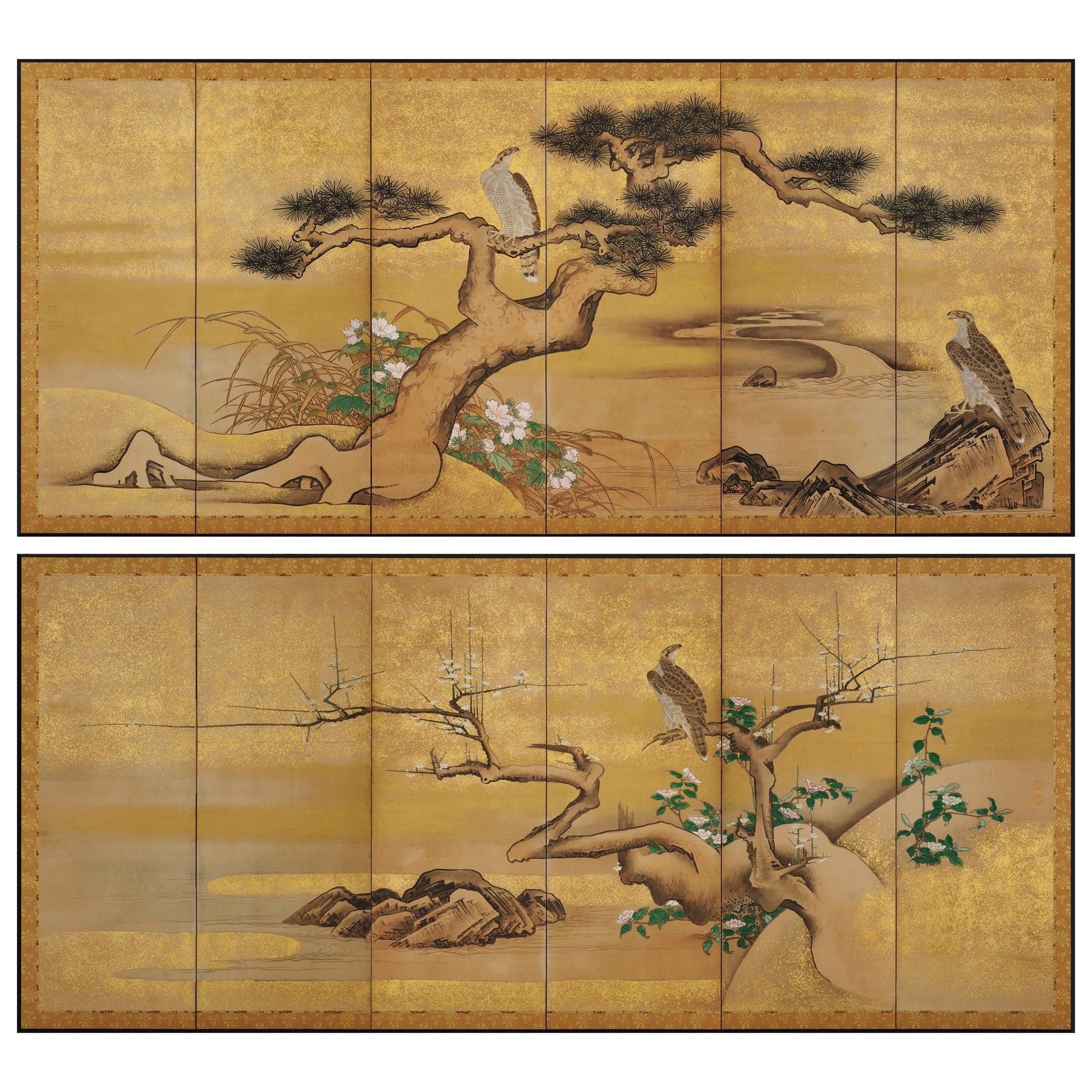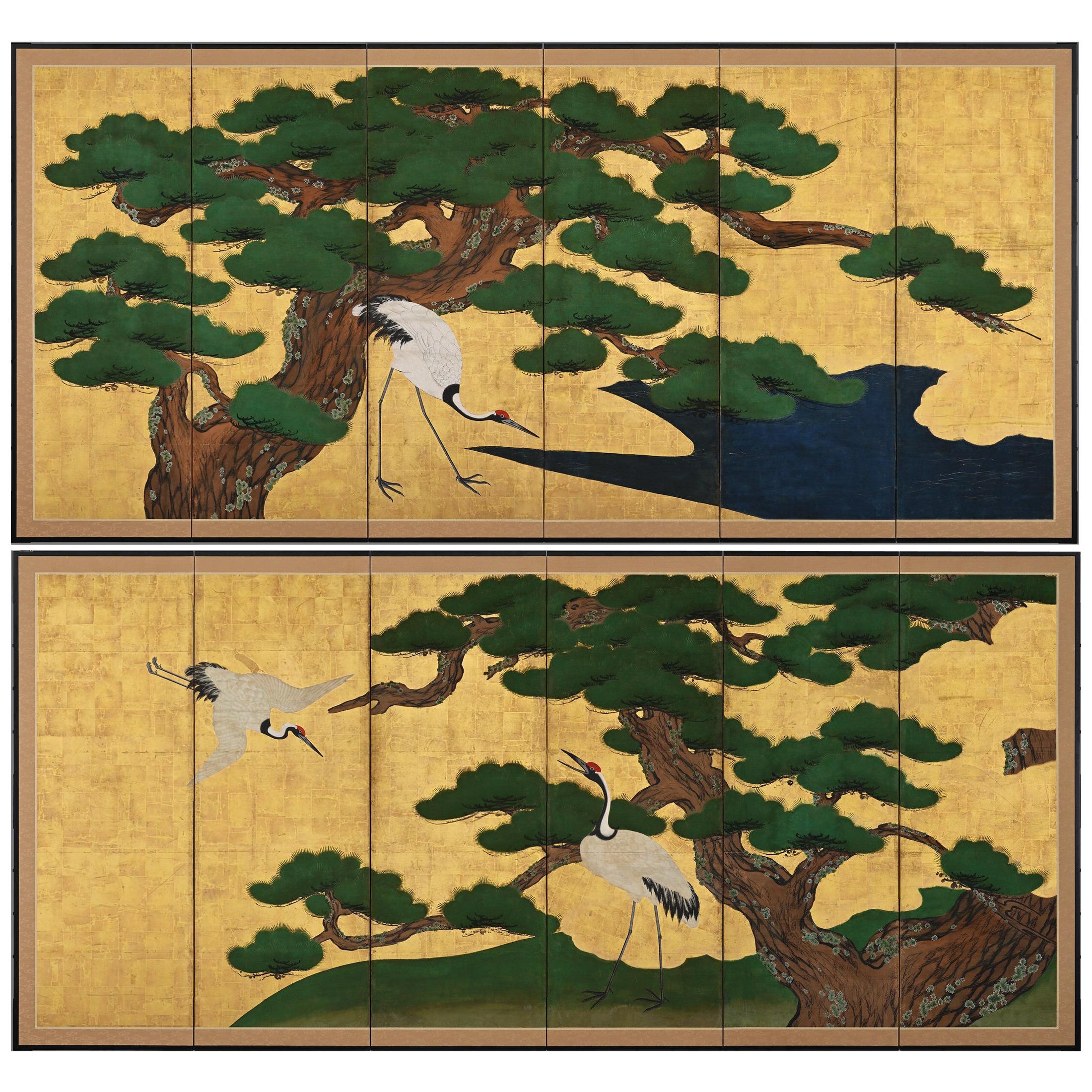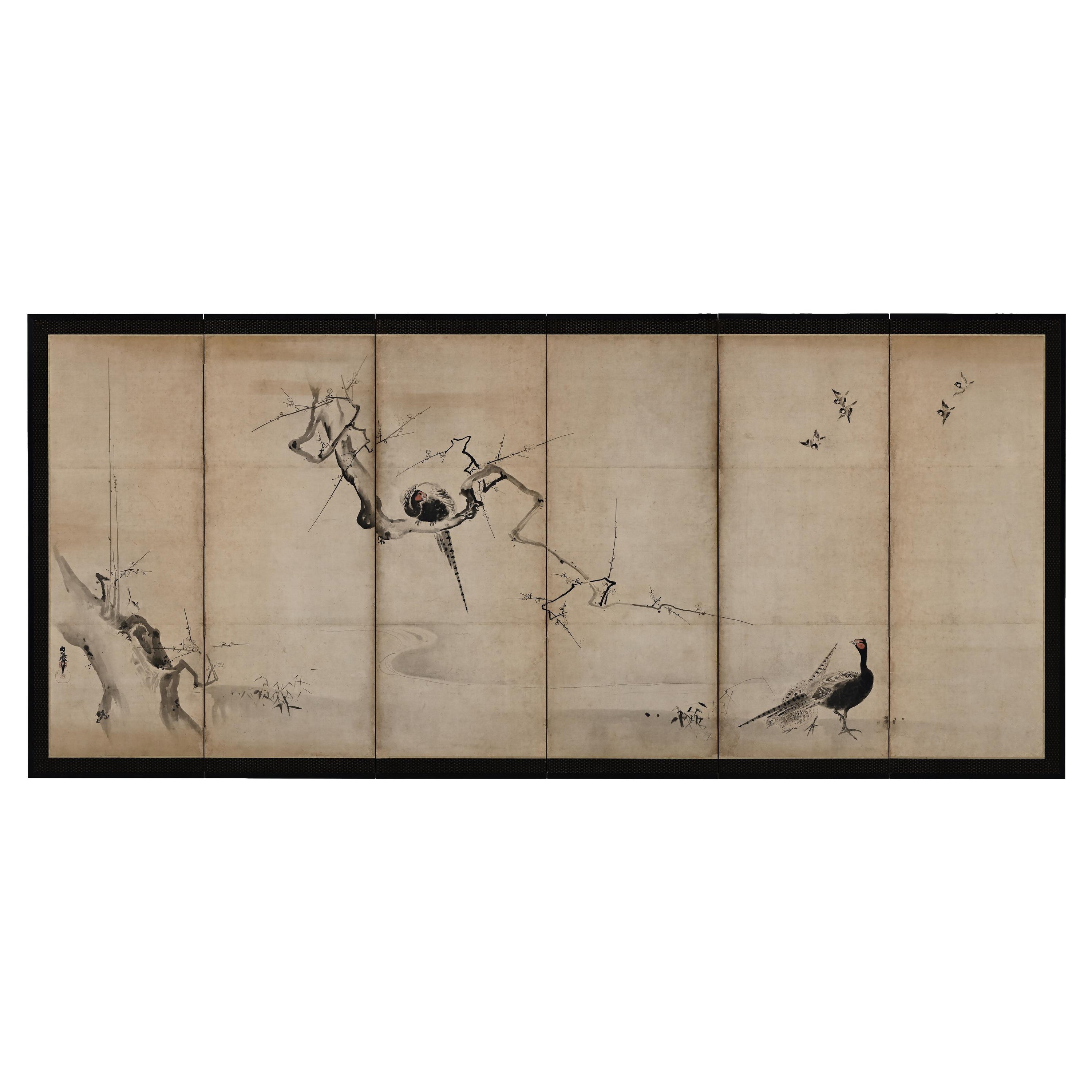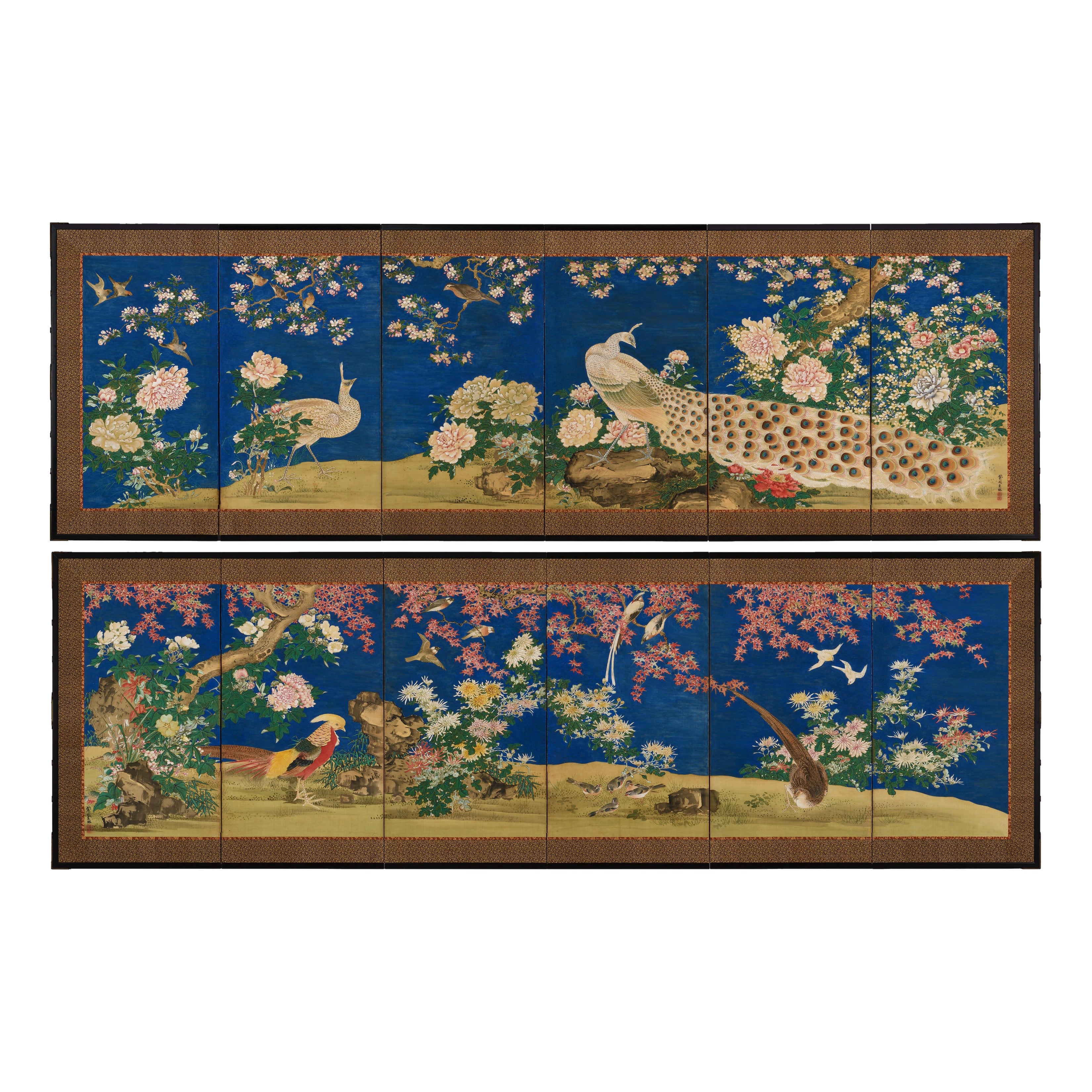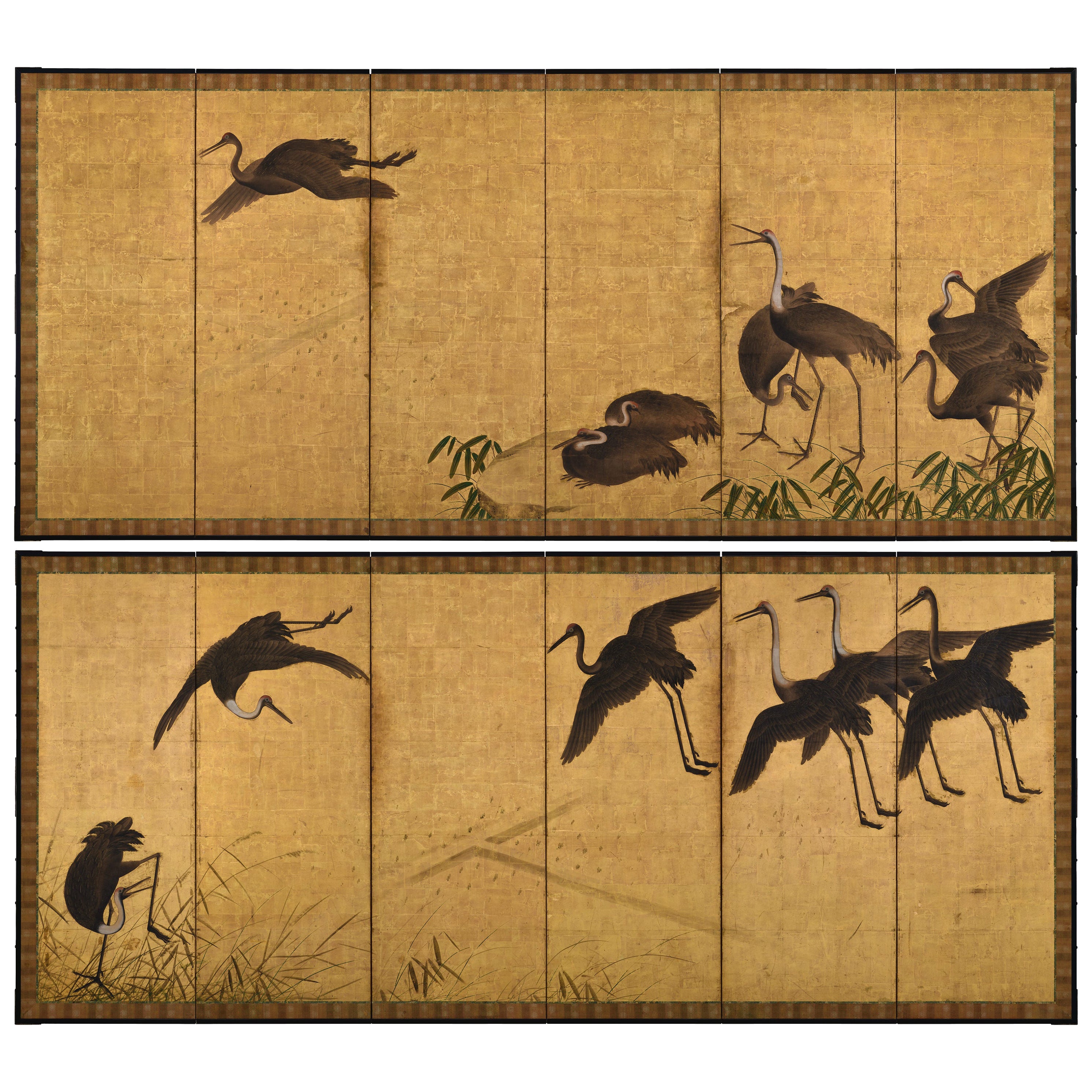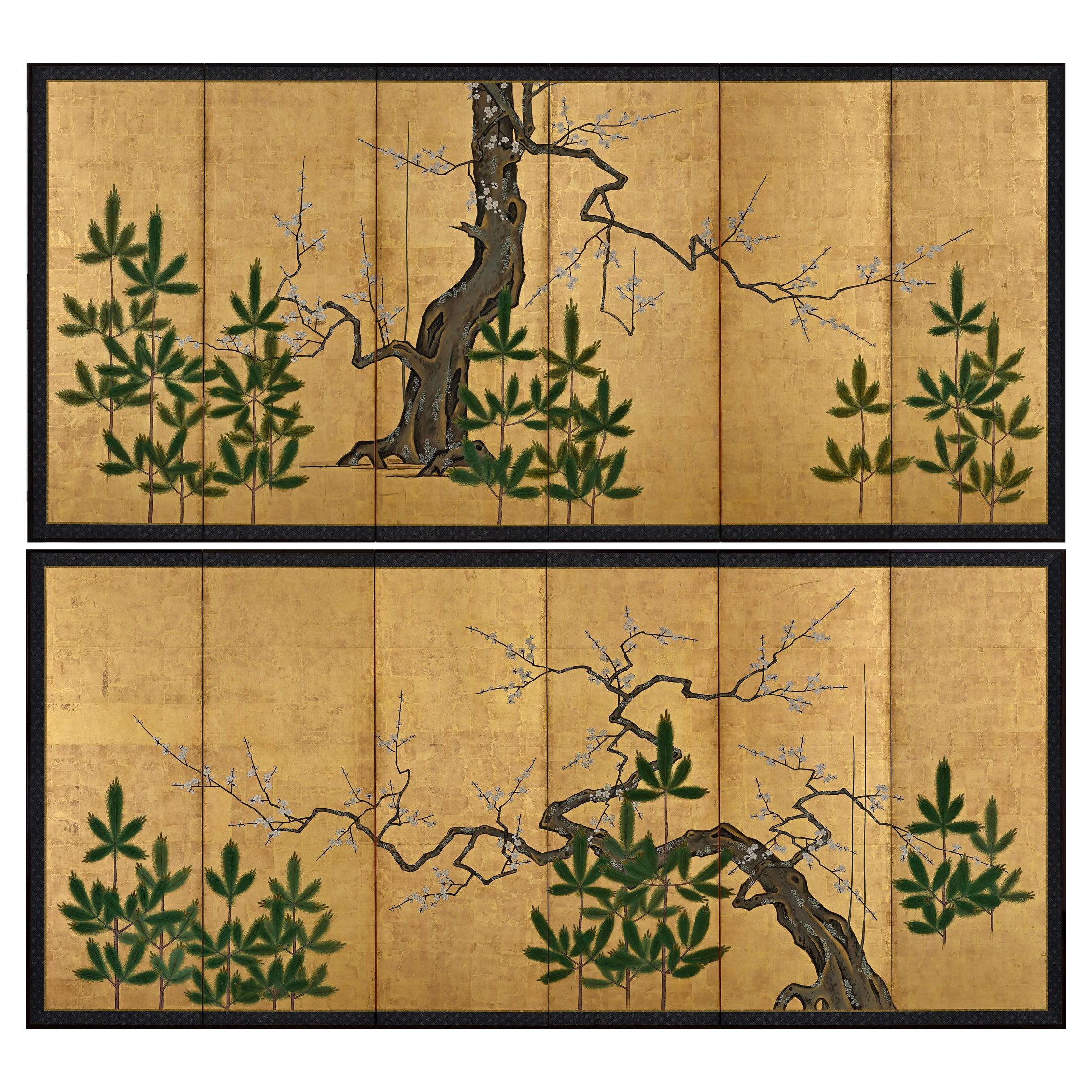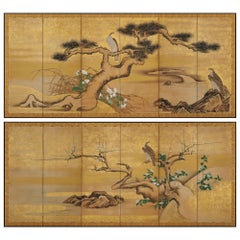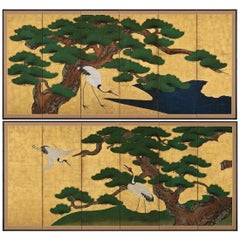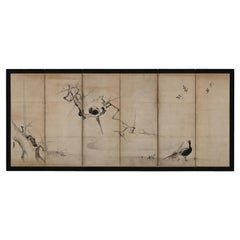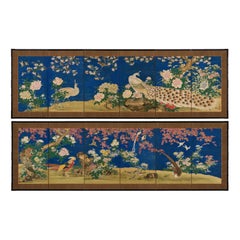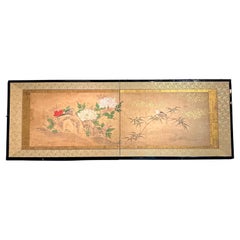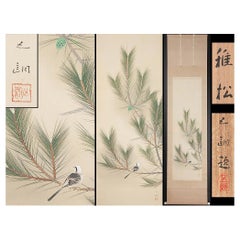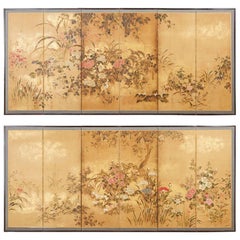Items Similar to Mid 18th Century Japanese Screen Pair. Crows & Pines by Unkoku Toshuku.
Want more images or videos?
Request additional images or videos from the seller
1 of 14
Mid 18th Century Japanese Screen Pair. Crows & Pines by Unkoku Toshuku.
$64,000per set
£48,613.23per set
€56,018.92per set
CA$90,127.85per set
A$99,920.05per set
CHF 52,511.88per set
MX$1,222,857.53per set
NOK 655,820.05per set
SEK 615,552.73per set
DKK 418,146.47per set
Quantity
About the Item
Unkoku Toshuku (1722-1779)
Crows and Pines
A pair of six-panel Japanese Screens. Ink and gold leaf on paper.
Dimensions: Each Screen: H. 170.5 cm x W. 375 cm
Haha-cho or mynah birds, whose forms resemble crows in artwork, were commonly depicted in Japanese art. These types of paintings were originally modeled on paintings attributed to the 13th century Chinese painter Muqi (Mokkei), whose art was enormously influential in Japan. Crows only became a theme among Japanese artists from the later 1500s onward. They likely were inspired by these imported Chinese paintings of myna birds, which are not native to Japan, substituting the native species of crow instead.
The best known early examples of the depiction of Japanese crows are two Momoyama screen paintings by Hasegawa Tohaku (Crows and Herons, Crows on Pine and Egrets on Willow) and a set of sliding doors attributed to Unkoku Togan (Ravens and Plum Tree). Both artists were strongly influenced by the work of Sesshu. The two artists eventually entered into a famous legal contest over succession to the line of Sesshu. The case was won by Unkoku Tōgan, who gained the right to call himself the ‘third generation of Sesshu.’ Another famous painting of crows is by Unkoku Toeki, the first son of Togan. This series of paintings mounted on screens is held in Konchi-in Temple in Higashiyama Kyoto. Large scale artworks depicting crows from the Momoyama and Edo periods are rare. Both the brushwork and the modeling of the crows in this pair of screens by Unkoku Toshuku are clearly indebted to the work of these founding Unkoku masters. Somewhere in the 17th century, the compositional model used here by Toshuku appears to have become somewhat standardized. Another screen utilizing the same model (left screen) was painted by Kano Chikanobu (1660-1728). Even so there are clear differences in brushwork of the birds and the pine and the overall atmosphere of the screens. In this work by Toshuku the jet black crows are the focus of the painting while the scratchy pines barely seem able to hold their weight. In the Kano school work more attention has been paid to the solidity of the pine with the crows blending in to their surroundings.
In Japanese art and culture, crows are captivating symbols, carrying layers of meaning that have evolved over centuries. In Shinto beliefs, crows are often viewed as messengers bridging the human world with the spiritual realm. Acting as intermediaries for deities, they can convey blessings or serve as omens, giving them a complex role in Japanese art and folklore. Within Japanese Buddhist art, crows symbolize the cycle of death and rebirth, reflecting life's impermanence and the journey of the soul. As creatures that both survive and scavenge, they highlight life's fragile balance and serve as reminders of mindfulness and the transient nature of existence.
Unkoku Toshuku (1722-1779) was a native of western Japan and a retainer for the Mori family, who lived in Nagato city in what is now Yamaguchi prefecture. He is part of a long line of Unkoku school artists who were descendent from Unkoku Touoku (1582-1615). After Togan (the schools founder) the lineage of the Unkoku school split in to two familial lines; Touoko and Toeki. Touoku was Togan’s eldest son, and his lineage is less well known. He died before his father so another son, Toeki, took the official reigns of the school and the title of ‘fourth generation of Sesshu’.
- Dimensions:Height: 67 in (170.18 cm)Width: 147.5 in (374.65 cm)Depth: 0.75 in (1.91 cm)
- Sold As:Set of 2
- Style:Edo (Of the Period)
- Materials and Techniques:
- Place of Origin:
- Period:
- Date of Manufacture:Circa 1750
- Condition:Refinished. Wear consistent with age and use. The screens have recently been fully restored and remounted in Kyoto utilizing traditional craftsmen and techniques.
- Seller Location:Kyoto, JP
- Reference Number:1stDibs: LU2472342171332
About the Seller
5.0
Recognized Seller
These prestigious sellers are industry leaders and represent the highest echelon for item quality and design.
Established in 2001
1stDibs seller since 2016
71 sales on 1stDibs
Typical response time: 16 hours
- ShippingRetrieving quote...Shipping from: Kyoto, Japan
- Return Policy
Authenticity Guarantee
In the unlikely event there’s an issue with an item’s authenticity, contact us within 1 year for a full refund. DetailsMoney-Back Guarantee
If your item is not as described, is damaged in transit, or does not arrive, contact us within 7 days for a full refund. Details24-Hour Cancellation
You have a 24-hour grace period in which to reconsider your purchase, with no questions asked.Vetted Professional Sellers
Our world-class sellers must adhere to strict standards for service and quality, maintaining the integrity of our listings.Price-Match Guarantee
If you find that a seller listed the same item for a lower price elsewhere, we’ll match it.Trusted Global Delivery
Our best-in-class carrier network provides specialized shipping options worldwide, including custom delivery.More From This Seller
View All17th Century Japanese Screen Pair by Soga Nichokuan, Hawks on Pine & Plum Trees
Located in Kyoto, JP
Hawks on plum and pine
Soga Nichokuan (active circa 1625-1660)
Pair of six-fold screens.
Ink, mineral pigments, gofun, gold and speckled gold l...
Category
Antique 1640s Japanese Edo Paintings and Screens
Materials
Wood, Paper
Circa 1700 Japanese Screen Pair, Cranes & Pines, Kyoto Kano School
Located in Kyoto, JP
Pines and Cranes
Anonymous. Kyoto Kano School.
Late 17th/early 18th centuries, circa 1700.
Pair of six-panel Japanese folding screens.
Ink, gofun, pigment and gold leaf on paper.
This bold composition presents two pine trees extending to the left and right across a gold leaf background. One tree is silhouetted against a green ground, golden clouds obscuring its true size, the other stretches across a stylized waterway. The pines are paired with Manchurian cranes with red crests and snow white plumage. Both have been highly auspicious motifs in East Asia since Chinese antiquity. Here the artist utilized fluid and instinctive ink brushstrokes to define the trunk, branches and tail feathers, in strong contrast to the precision and sharp angularity of the crane’s legs and beaks. The adoption of this vast metallic painting support required an unerring sense of design and composition, so that the negative space surrounding motifs could imply context for the otherwise floating pictorial elements. The brushwork detailing the trunks of the pines, the exaggerated dimensions of the pine trees and the strength and dynamism of the composition are all reminiscent of Kano Eitoku...
Category
Antique Late 17th Century Japanese Edo Paintings and Screens
Materials
Gold Leaf
17th Century Japanese Screen. Ink Plum Tree & Birds by Kano Naonobu.
Located in Kyoto, JP
Kano Naonobu (1607-1650)
Plum Tree and Birds
Six-fold Japanese Screen. Ink and slight color on paper.
In this evocative ink work spread over a six-panel folding screen, we see the consummation of the elegance and refinement of the Edo Kano school. This 17th century screen is a rare surviving example of a large-scale bird and flower painting by Kano Naonobu, the younger brother of Kano Tanyu...
Category
Antique 17th Century Japanese Edo Paintings and Screens
Materials
Wood, Paper
Mid 19th Century Japanese Screen Pair. Flowers & Birds of the Four Seasons.
Located in Kyoto, JP
Shioka Sorin (1781-1850)
Flowers & Birds of the Four Seasons
Pair of six-panel Japanese Screens. Ink, gofun and pigments on silk.
Dimensions (each screen): H. 91.5cm x W. 285cm (3...
Category
Antique Mid-19th Century Japanese Edo Paintings and Screens
Materials
Silk
17th Century Japanese Screen Pair. Flock of Cranes. Ink and color on gold leaf.
Located in Kyoto, JP
A pair of six-fold Japanese screens from the 17th century depicting a flock of cranes arriving at their wintering grounds. The expansive scene is heavily atmospheric. The cranes are...
Category
Antique 17th Century Japanese Edo Paintings and Screens
Materials
Gold Leaf
18th Century Japanese Screen Pair. Plum & Young Pines. Kano School.
Located in Kyoto, JP
Dimensions (Each screen): H. 176 cm x W. 378 cm (69’’ x 149’’)
This pair of Japanese folding screens depict blossoming plum trees amongst young pines. They are designed to capture t...
Category
Antique Late 18th Century Japanese Edo Paintings and Screens
Materials
Gold Leaf
You May Also Like
Antique 19th Century Japanese Two-Panel Screen ‘Byobu’, Kano School, Edo Period
Located in London, GB
Japanese Kano School Edo period two-panel screen depicting flowering prunus and bamboo on a rock formation, with colorful birds next to a body of water. ...
Category
Antique Mid-19th Century Japanese Edo Paintings and Screens
Materials
Gold Leaf
Japanese "Magpie and Peony" Two Panel Screen, Edo Period, 18th/19th century
Located in Austin, TX
A sublime Japanese two panel "Magpie and Peony" screen, ink and color on paper, Edo Period, late 18th or early 19th century, circa 1800, Japan.
The two panel screen features a wond...
Category
Antique Early 19th Century Japanese Edo Paintings and Screens
Materials
Copper
Japanese Nihonga Painting 20th Showa/Taisho Scroll Pine Tree and Bird
Located in Amsterdam, Noord Holland
Hanging scroll "Wakamatsu" silk version, painted, signed in box
size Axis: Height 208.5cm Width 49.5cm
Drawing: Height 123cm Width 36cm *There may be slight differences in dimension...
Category
20th Century Taisho Paintings
Materials
Silk
$1,709 Sale Price
20% Off
Pair of Japanese Edo Rimpa School Screens after Tawaraya Sōtatsu
Located in Rio Vista, CA
Impressive pair of 17th century Japanese Edo period Rinpa school screens made in the manner and style of Autumn Grasses by Tawaraya Sōtatsu (1570-1640). Beautifully decorated with wi...
Category
Antique 17th Century Japanese Edo Paintings and Screens
Materials
Gold Leaf
Japanese Two Panel Screen Manchurian Crane and Turtles
Located in Hudson, NY
In Japan, cranes symbolize fidelity as they mate for life and turtles symbolize longevity. Additionally, this screen also has the Japanese motif of sho-chiku-bai, or the three friends of winter (pine, plum, and bamboo). So called the three friends of winter because all three flourish during the cold months. This screen was originally fusuma doors...
Category
Antique Mid-19th Century Japanese Edo Paintings and Screens
Materials
Paper
Japanese Two Panel Screen: Hawk Perched in Pine Tree
Located in Hudson, NY
Hawks were a popular motif in artwork because Japanese falconry, or takagari, was a sport of aristocrats such as nobles and samurai. Hawks came to symbolize nobility and strength. Su...
Category
Antique 17th Century Japanese Paintings and Screens
Materials
Brocade, Silk, Paper
More Ways To Browse
Mid Century Screen
Dior Asia
Painting Antique Pine Furniture
18th Century Bird Painting
Used Screen Doors
Gold Chinese Screen
Antique Chinese Painting Of Birds
18th Century Hand Screen
Japanese Screen Tree
Japanese Screen Kyoto
Antique Ink Well Set
Pair Of Japanese Screens
Japanese Door Panels
Painted Panel Screen Birds
Edo Screen Gold
Chinese Screen With Birds
Antique Crow
Japanese Painted Door
